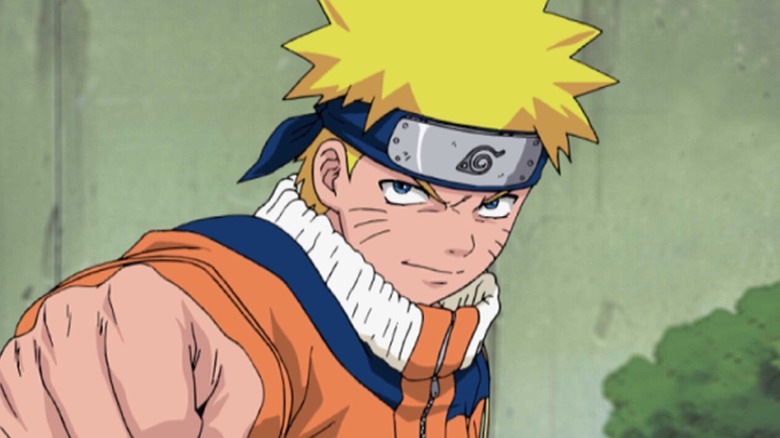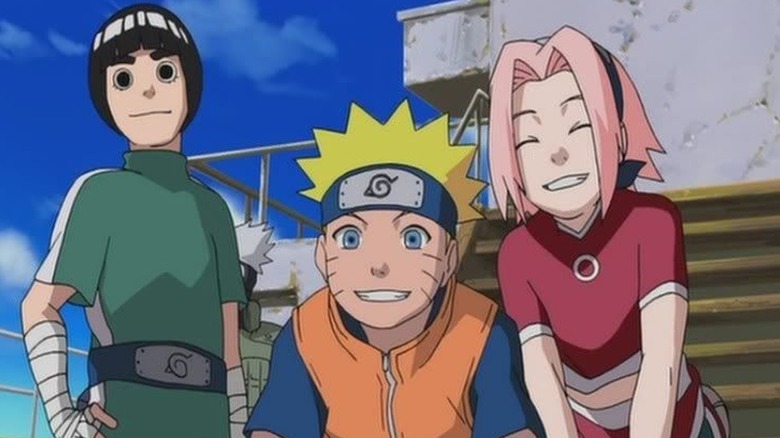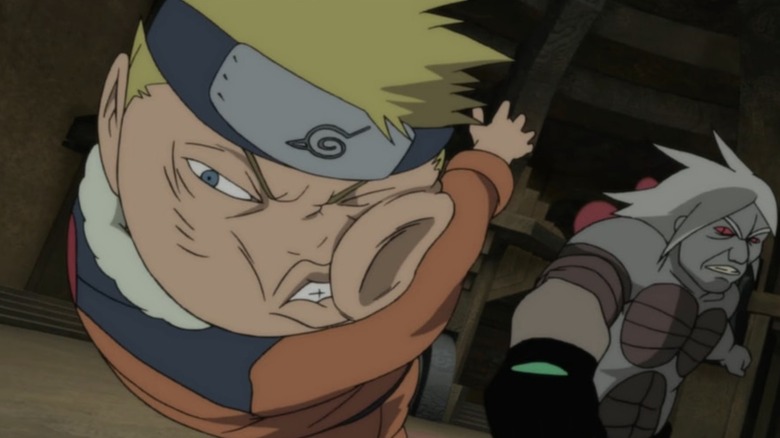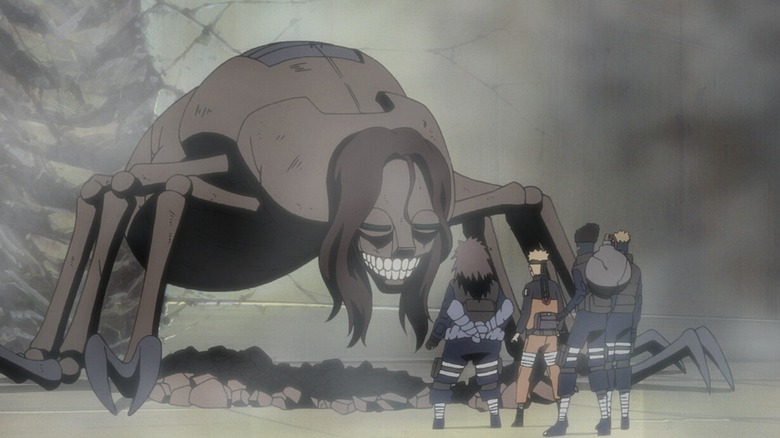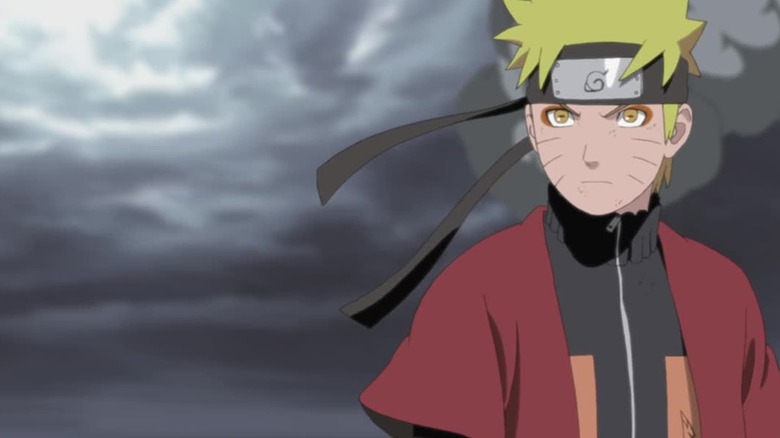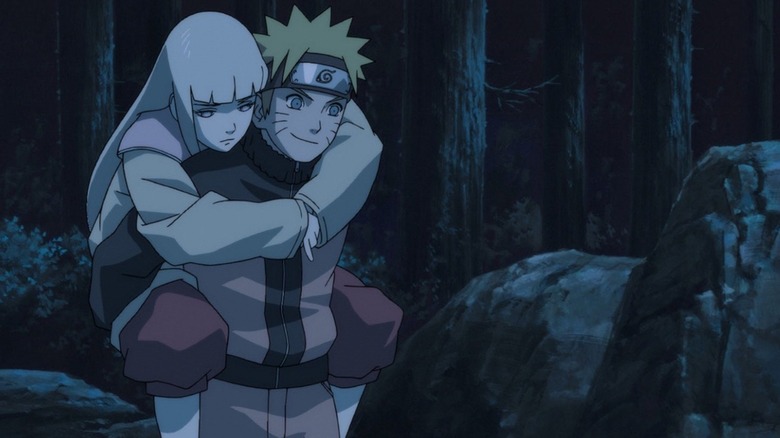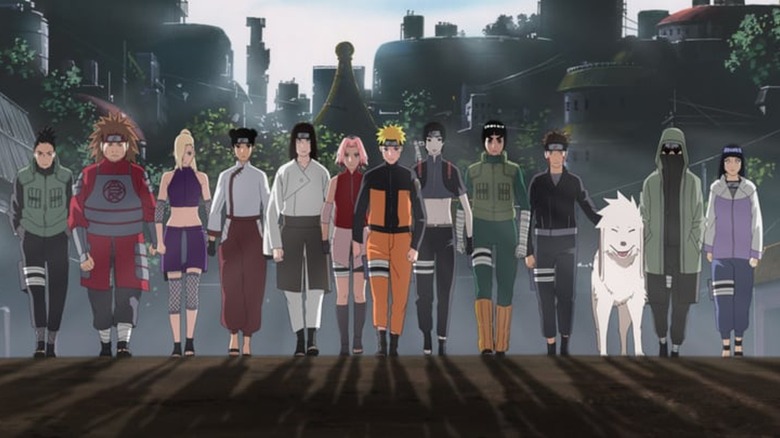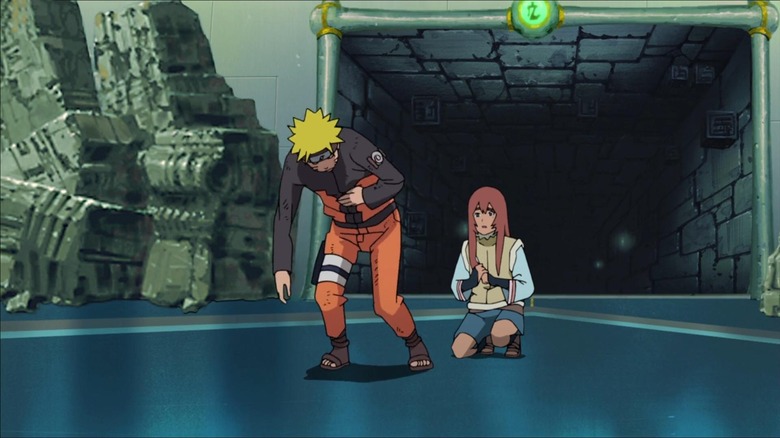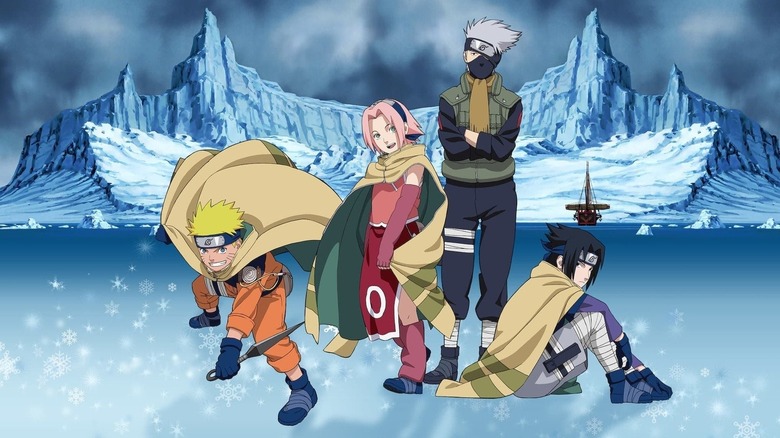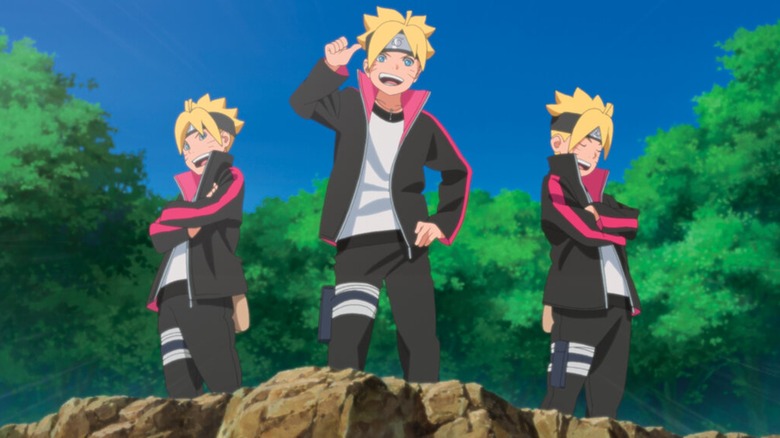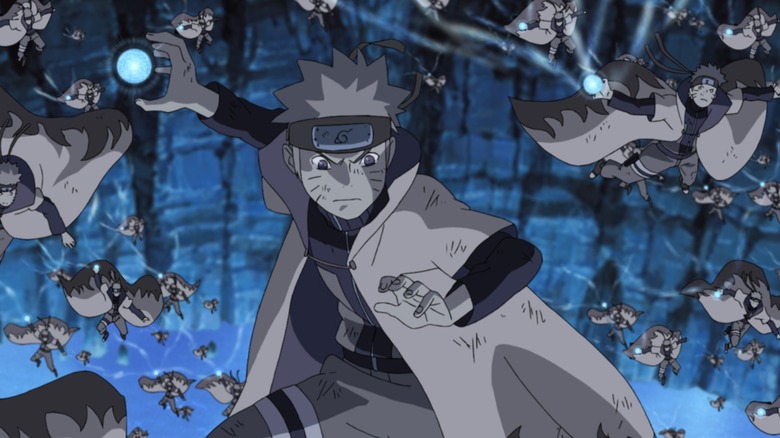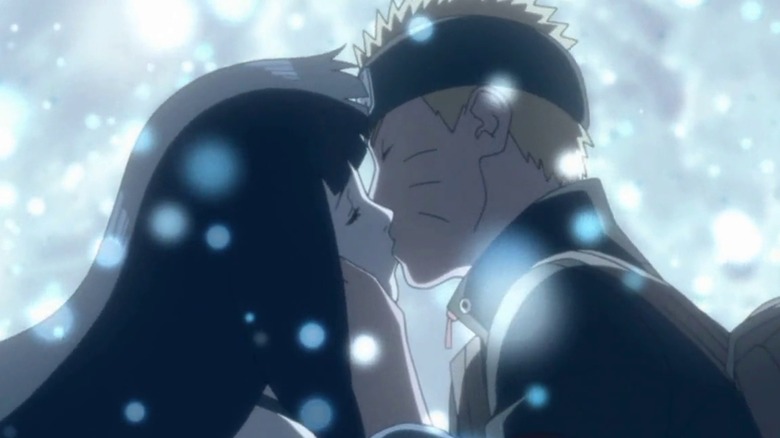Every Naruto And Boruto Movie Ranked From Worst To Best
It's not unusual for the movies to come out of manga and anime series to feel a little off. The stories are often non-canon or otherwise abridged adaptations of ongoing story arcs, and the best thing you can hope for as a viewer is that a given movie captures some hint of what you enjoy about the series. While the movies may not hit the heights of the series, they can still deliver excellent character moments and action.
Whether or not the "Naruto" films deliver on that is up for debate. As the manga and anime series focused on the growth and development of its title character, a young ninja (Junko Takeuchi in the Japanese dub, Maile Flanagan in the English) in a fantasy world on the path to glory, the movies give him and some of his coterie of allies non-canonical missions on which they can prove their mettle. For a series weighed down with a large number of "filler arcs" after the major departure of anti-hero Sasuke (Noriaki Sukiyama, Yuri Lowenthal), such non-canon movies could be seen as even more nonessential. But that's not exactly the case.
The "Naruto" franchise is pretty vast. There are three "Naruto" series, from the original to "Naruto: Shippuden," its more mature follow-up, and ultimately "Boruto: Naruto Next Generations," which deals with the original characters' children. Of the eleven movies produced for the franchise, the quality varies, but you can generally expect something similar out of each: Naruto and friends go on a ninja mission, there are some cool fight scenes, there is a message about friendship, and the status quo is regained by the ending.
11. Naruto The Movie 3: Guardians of the Crescent Moon
This film, the third to come out of the "Naruto" franchise and the last before the advent of "Naruto: Shippuden," was directed by Toshiyuki Tsuru. It follows Naruto as his team — Sakura, team leader Kakashi, and Rock Lee (Kate Higgins, Dave Wittenberg, and Brian Donovan) — is assigned a mission to protect Prince Michiru (Michael Sorich) and his son, Hikaru (Kari Wahlgren). The two royals hail from the Land of the Moon, an extremely wealthy kingdom, and their carelessness around money extends to their treatment of everyone, whether it's their own staff or the ninja team they hire for protection.
Because this movie follows the formula of the rest to a tee, its quality is directly related to the nature of its new characters. Michiru and Hikaru are largely uninteresting and shrill, beginning the movie as desperately unlikeable on account of their wealth. While they both grow up over the course of the movie, becoming more conscious of how they treat others and the consequences of their wealth, they are still the least compelling of any "Naruto" movie characters. The palace intrigue that dominates much of the plot is also dull. Shabada (Terrence Stone), the opportunistic minister with an eye on the throne, hires assassins who rank among the most generic heavies in the franchise.
While Rock Lee and Kakashi are quite a bit more limited in this film than in the series proper, there is still some solid action as can be expected from the franchise. Near the climax, the villainous Ishidate (Christopher Corey Smith) uses his petrification gauntlet against Naruto, forcing him to figure out how to fight while his legs are essentially frozen, which results in a slick conclusion.
10. Naruto The Movie 2: Legend of the Stone of Gelel
"Legend of the Stone of Gelel" was the second film to come out of the "Naruto" franchise, and it arrived in the middle of a major block of filler storylines in the series. The titular stone is very powerful, and when fused with a living thing, provides additional power as well. It's essentially a MacGuffin, something to drive the plot, which in this case is one of the more convoluted storylines in any of the "Naruto" movies. It's not helped by the story of Temujin (Roger Craig Smith) feeling like a loose, unimaginative remix of some of the more tragic backstories from the canonical storylines.
Despite opening with a beautifully animated sequence of an attack on the Sand village, the movie proper begins with Naruto, Sakura, and Shikamaru (Tom Gibis) on a mission to escort a ferret back to his home. They are attacked by the mysterious Temujin, clad in the armor of a knight, as well as the soldiers from the opening scene. After the fight, Temujin and Naruto end up in the village that hired the ninja to bring back the ferret, who is even older than the village elder.
We learn eventually that the ferret, who has a special connection with Temujin, has the Stone of Gelel inside him, and that Temujin is a morally conflicted puppet of the villainous Haido (Douglas Rye). Haido is really just interested in using his army to destroy the world and build a utopia out of the wreckage. For a series that drew occasionally from Quentin Tarantino, this movie would have benefited from a bit more of that edge.
Luckily, the movie does benefit from bringing in some fan-favorite characters, like Shikamaru and Gaara (Liam O'Brien), even if the latter is just a brief appearance.
9. Naruto Shippuden The Movie: The Lost Tower
"The Lost Tower" was the fourth film to come out of the "Naruto: Shippuden" series, and it engages a great deal with the lore, far more than the "Naruto" movies typically do. Much of this can be attributed to the meat of the movie involving Naruto being transported 20 years into the past along with the villain. While the movie takes on an ambitious time travel story, at its core it ultimately could be changed out with pretty much any storyline. Naruto and his teammates are on a mission, the mission goes badly, and an adventure begins.
With the "Shippuden" era fully in by this film, Naruto's team includes not just Sakura, but Yamato and Sai (Troy Baker and Ben Diskin). Nevertheless, the team and the familiar supporting cast of the series are pretty much nonexistent throughout this movie. As they pursue missing-nin Mukade (J.B. Blanc) in the opening, he and Naruto end up traveling through a flash of light that sends them decades in the past. There, Naruto meets friends old and new, like Chōza (Michael Sorich). He also meets the future Fourth Hokage, and the man he learns is his father, Minato (Tony Oliver). Meanwhile, Mukade has traveled back further than Naruto and installed himself as the minister of Rōran, a kingdom in the Land of Wind, by using his knowledge of the future.
As far as the actual time travel goes, this movie would not make a list of the best. By the storyline's end, Minato and Naruto part ways with their memories of the events erased, making the movie feel even less canonically relevant than if it was entirely filler-based. Moreover, the characterization of Minato feels like a missed opportunity given how heavily his shadow weighs over the series.
8. Naruto Shippuden: Blood Prison
"Blood Prison" was the fifth movie to come out of "Naruto: Shippuden," and probably the "Naruto" movie with the most evocative title. Unfortunately, it's in service of one of the most surprisingly boring movies of the series, especially given the premise. Many "Naruto" movies have stretches that are a little dull, and it usually falls on the movie-only characters, but "Blood Prison" is one of the worst for that.
Framed for an assassination attempt, Naruto is sent to the titular prison, where he tries in vain to break free. In typical Naruto fashion, he uses clones and whatever tricks he can, but ultimately, prison master Mui (Matthew Mercer) has the power on his side. What could have been a great prison break movie with the series's penchant for imaginative, unique antagonists goes nowhere quickly, ultimately defaulting to a standard demonic monster story.
Much of that has to do with Mui's objective, protecting the Box of Infinite Bliss, another kind of uninteresting MacGuffin that could theoretically grant the wish of anybody who opens it. A big box with a demon face, it looks like the opposite of its name. Mui has even lost his son to the Box, as Naruto learns from Ryūzetsu (Carrie Keranen), a former friend of Mui's son Muku (Bryce Papenbook). She ended up in prison after Muku was absorbed into the Box.
Naruto eventually learns that he was sent to prison for the express purpose of destroying the box, resulting in a visually interesting but fairly empty climax. As Muku and the Box turn into the winged Satori and Naruto enters Sage Mode, the movie finally gets into a solid, if predictable, groove. The arrival of Killer B (Catero Colbert) is nice, too.
7. Naruto Shippuden: The Movie
The first movie to come out of the "Shippuden" era, and also one of the weakest, opens with a shocking vision of the future: Naruto's death. With this ticking time bomb flashforward, it would be reasonable to expect some level of tension from the movie, but the story is ultimately a bit more generic, dealing with an evil demon and the priestess who is the heroes' only hope of keeping it sealed away.
Naruto's death was actually a vision of the priestess, Shion (Laura Bailey), and he is assured despite his skepticism that her visions are 100% accurate. Given her abilities, she has become a target, and assassins are sent after her. Naruto, along with Rock Lee, Sakura, and Neji (Steve Staley), is sent to protect Shion. Meanwhile, with his only enemy in danger, the demon, Mōryō (Daran Norris), finds a willing human host to possess until he can reconnect with his own body.
Some of the epic-scale fighting with the stone army of Mōryō makes for some of the cooler action scenes within the "Naruto" movies, and the story of Shion makes for a more interesting supporting character than what a decent amount of the movies go for. The material with Yomi (Vic Mignogna), who is possessed by Mōryō, is not on the level of the best movies about demonic possession, but still gives the storyline some tense energy.
The Shion story, especially getting to the final confrontation, has a level of dramatic weight to it that not every movie in the series gets to, and when she and Naruto form a Super Chakra Rasengan to fully destroy the unlocked Mōryō, it makes for a satisfying resolution. Besides that, there are long dull stretches throughout, even if it reaches new heights.
6. Naruto Shippuden The Movie: The Will Of Fire
Despite having a weakly assembled plot, "The Will Of Fire" makes for one of the more successful "Naruto" films. As the third movie to come out of the "Shippuden" era, it's one of the few to really dig into the franchise's deep bench of supporting characters, using the added budget of a feature film to portray the skills of the various ninjas with dazzling flare. While the story isn't particularly effective, its emphasis on Kakashi and Shikamaru gives it a rare sense of emotional depth.
While not strictly canonical, "The Will Of Fire" does draw from the anime in a way few of the movies do. With the threat of an upcoming ninja world war on everyone's minds, the world takes the disappearance of a handful of ninjas with Kekkei Genkai (special, inherited abilities) very seriously. The only country not to lose a ninja was the Land of Fire, to which Naruto's home of Konoha belongs. Konoha then must prove its innocence.
Hiruko (Todd Haberkorn), a former ally of characters like pervy sage Jiraiya (David Lodge) and 5th Hokage Tsunade (Debi Mae West), is the man really responsible, and he has an interest in kicking off the war. More than any other movie in the series, the story of "Will Of Fire" feels like an excuse to place all the characters together, particularly when Sakura and Naruto must work together with a big chunk of the supporting cast to take on the chimera summoned by Hiruko. Still, with the familiar "Naruto" sense of humor in place, it comes together.
5. Naruto Shippuden The Movie: Bonds
"Bonds" is the second movie to come out of "Naruto: Shippuden," and it lands pretty effectively. It's also one of the few movies to incorporate Hinata (Stephanie Sheh) in a serious way, which ends up being quite significant for the endgame of the series. Most importantly, "Bonds" brings Sasuke back to the fore, in a way that teases major developments but ultimately is returned to the status quo by the end of the movie. Sasuke even gets the focus of the cold open, meditating in a waterfall near his master Orochimaru (Steven Blum), but both of them appearing feels pretty low-key next to the actual story of the movie.
In the opening scene of "Bonds," Naruto's home village of Konoha is attacked by ninja from the Land of the Sky, all of whom are using devices to fly. They bomb the village in one of the biggest-scale action scenes in the series. Following that, the movie mostly shifts back to the traditional "Naruto" movie mold, as Sakura, Hinata, and Naruto escort the refugee Amaru (Michelle Ruff), who is pretending to be a boy while in the village, back to her hometown, as well as her sensei Shinnō (Jamieson Price).
Predictably, Naruto ends up teaching Amaru a bit about life and friendship while her sense of what's right is hurt by mid-film revelations. As it turns out, Shinnō and Orochimaru have a bit of history — the latter's body-swapping immortality owes a lot to the former's medical experimentation, explaining why Orochimaru sent Sasuke out in the first place. The climax gets into some surreal body horror, and it's cool seeing Sasuke and Naruto fighting together, but the end result is just a better-than-average "Naruto" movie.
4. Naruto The Movie: Ninja Clash In The Land Of Snow
"Ninja Clash In The Land Of Snow" was the first "Naruto" movie, and thus was the only one to feature the original trio of characters leading the story. With Team Kakashi, including Naruto, Sakura, and Sasuke, on the mission, there is a lot of nostalgia involved. Prior to the more convoluted and mystical storylines that later movies and chapters of the anime hit, there's something pleasantly quaint about the movie simply dealing with the protection of a princess.
There is also something quaint in opening with the characters in a movie theater, simply watching the exciting adventures of a mythical princess and then meeting her actress moments later. Rather than the more action-packed openings of later movies, this sets the tone in a way that feels truer to the more laid-back days of the show.
Yukie (Kari Wahlgren) is the actress who played the princess, but she's also a princess herself. Kakashi saved her when her kingdom in the Land of Snow was taken over in a coup, and now he's entrusting his team with protecting her in the wake of a new movie production in her former land, where everybody believes her to be dead. This fun, inventive storyline is a far cry from the dramatic, demonic places some of the later movies would go, and the ensemble cast works excellently.
As "Naruto" creator Masashi Kishimoto once suggested, a big part of the franchise's success can be owed to the fact that the character can be a bit of a fool. He's a good hero for that reason, but it does mean that when he's the sole character from the series's deep bench to show up, the movies can get a little weaker. With its fun cast, "Ninja Clash" avoids that problem.
3. Boruto: Naruto The Movie
"Boruto" not only concludes the story of "Naruto," it gives viewers a look into the future of the beloved characters. While the movie would eventually be adapted into the manga and anime series "Boruto: Naruto Next Generations," it works beautifully as a standalone story of what it means to turn over the spotlight to the next generation while still having several open ends for any potential follow-up. It's infinitely more successful than something like, say, "Harry Potter and the Cursed Child" when it comes to following up on beloved stories that centered on both coming of age and surviving as well as winning a war.
With Naruto serving as the Seventh Hokage, his son with Hinata, Boruto (Amanda Celine Miller), has some of each of his parents' traits. His personality is a little more muted than his father's, but just as confident. And his relationship with Sakura and Sasuke's daughter Sarada (Cherami Leigh) is a bit of an echo with the rivalry and friendship between Naruto and Sasuke. Meanwhile, Boruto struggles with his father and even suggests that he got off easy by not having any parents.
If the worst part of the "Naruto" movies is the amount of dead air you sometimes get, the worst part of "Boruto" is that it runs just an hour and a half. That's standard length for a "Naruto" film, but ultimately too short for every incident and character the movie wants to introduce and reintroduce to the series. You spend a lot of time playing catch-up, and the characters are drawn much more compellingly like in the best parts of the canon manga. Luckily, the storyline of the movie is given ample time to stretch during the anime adaptation, which turns it into a full-on arc.
2. Road To Ninja: Naruto The Movie
"Road to Ninja" was the sixth film to come out of the "Shippuden" era, and one that comfortably looks back at the whole of the series in a look at an alternate universe straight out of "It's A Wonderful Life." The previous "Shippuden" film "The Lost Tower" threw Naruto directly into the past, but it didn't draw much in the way of characterization. "Road To Ninja," while being another movie dealing with an out-there concept for the series, is deeply concerned with the characters that series creator Misashi Kishimoto conceived.
Digging into the lore, "Road to Ninja" imagines a world where the initial conceit of the series is flipped on its head. At the beginning of "Naruto," the character is lost in the world, an aspiring ninja without parents and friends but with an unflappable optimism. Naruto's life was set up when his father Minato, the 4th Hokage of Konoha, sacrificed his life to seal the Nine-Tailed Demon Fox within him as a baby. Meanwhile, Sakura was left to live a peaceful life with overbearing parents.
Early on in "Road to Ninja," the two enter an alternate universe where they find they've switched places. If the most common problem across the "Naruto" films is their loose relationship to the continuity of the series, this movie is the only one to meaningfully play with that idea. Naruto is grateful to be with his parents again (even if it's just an illusion) and Sakura is grateful to be without her parents, but she begins to understand Naruto better as the loneliness gets to her.
The emotional impact of "Road to Ninja" goes beyond the typical overbearing message of friendship the movies tend to explore.
1. The Last: Naruto The Movie
"The Last" was, of course, the last mainline film to come out of the "Naruto" franchise (followed up only by "Boruto"). By the end of the film, the characters are ready to enter the next step of their lives, following the Fourth Shinobi World War and the final arcs of the anime. In particular, "The Last" is concerned with the romantic lives of Naruto and Hinata, a character who has always been deeply in love with Naruto even during their childhood, when he was widely despised. "The Last" is one of the few films in the "Naruto" franchise to meaningfully expand on what exists in the canon.
While it's not as innovative as the actual anime could be, "The Last" is instead a solidly built character-oriented story. If the mission isn't especially exciting, it matters less than the unique, laidback pace that excels in producing a beautiful farewell to the initial run of "Naruto" storylines.
If anything, the weakest parts of the movie deal not with Naruto and Hinata's relationship but with the enemy, Toneri Ōtsutsuki (Robbie Daymond), a human-hating extremist from the Moon. His storyline, which involves kidnapping Hinata's sister to be his wife and destroying humanity for using chakra for war, is a little typical, and his design inspires little in the way of fear. Still, the "Naruto" movies are no stranger to generic villains, and "The Last" has great qualities that go far beyond that.
Major character storylines are also wrapped up — besides Naruto and Hinata finally falling in love, Sasuke's help in evacuating the town from a meteor storm suggests a really strong resolution to his conflicted arc. As well, the epilogue leads very directly to "Boruto," in a moment that suggests the ways life goes on.
